1. Kurukshetra War
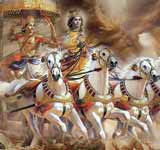
Pandavas Kauravas The Kurukshetra war or Mahabharat War was fought between the Kauravas and the Pandavas to attain the throne of the Kuru kingdom. According to Mahabharata, almost all the districts of India participated in this war. According to Mahabharata and other Vedic literature, this was the largest war in the history of Vedic period in ancient India. Millions of Kshatriya warriors were killed in this war, which resulted in the collapse of Vedic culture and civilization. Apart from kings from all over India, Kshatriya heroes from many other countries also participated in this war and all were killed. As a result of this war, India lacked both knowledge and science as well as heroic Kshatriyas. In a way, the Vedic culture and civilization which was at the peak of development was abruptly destroyed. The golden Vedic civilization of ancient India came to an end with the end of this war.
2. Indo-Pakistani War of 1971
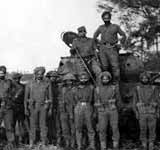
India Pakistan The Indo-Pak War of 1971 was a military conflict between India and Pakistan. Due to the freedom struggle of erstwhile East Pakistan, it started from 3 December 1971 to 16 December 1961 and ended with the surrender of Dhaka. The war began with preemptive airstrikes by Pakistan at 11 stations of the Indian Air Force, resulting in the Indian Army jumping into support of Bengali nationalist groups in the Bangladeshi independence struggle in East Pakistan. This war lasting only 13 days was one of the shortest wars recorded in history. Pakistan suffered a major defeat in the 1971 Indo-Pak War. East Pakistan became independent and formed a new country in the form of Bangladesh. The Pakistani army surrendered on 16 December.
3. Battle of Haldighati
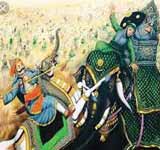
Mughal Empire Mewar The battle of Haldighati was fought between Mughal Emperor Akbar and Maharana Pratap on 18 June 1576 AD. This war between Akbar and Rana proved disastrous like the Mahabharata war. It is believed that neither Akbar nor Rana lost in this war. If the Mughals had more military power, then Rana Pratap had no shortage of combative power. He did not accept the treaty with Akbar till the last time and kept fighting battles while living life with respect. The war had become very terrible. Seeing Rana Pratap's attack on Salim, many Mughal soldiers grew on the same side and surrounded Pratap and started attacking from all four sides. The Rajput soldiers also struggled to save Pratap by putting his life on his palm. But slowly Pratap was getting trapped in crisis. After examining the seriousness of the situation, Jhala Sardar sacrificed his life, presenting an incomparable ideal of loyalty.
4. Battle of the Hydaspes
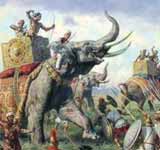
Porus Alexander The battle of Hydaspes was a battle fought by Alexander the Great in 326 BC against Porus (Paurava or Purushotthama in Sanskrit), the king of Paurava (Indian kingdom located in the Punjab that today is part of Pakistan, near the Hydaspes River (today known as Jhelum River). This was the last great pitched battle fought by Alexander: although victorious, the exhausted Macedonian army mutinied, refusing to advance further into the interior of India. On the basis of a new study, Sir W. Tarn has reported that the army of Porus had 4000 cavalry, 300 chariots, 200 elephants and 30,000 infantry, while Alexander had 53,000 cavalry and about 15,000 infantry.
5. Third Battle of Panipat
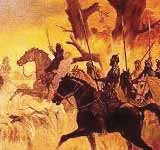
Maratha Empire Ahmad Shah Abdali The third battle of Panipat took place between Ahmed Shah Abdali and the Maratha commander Sadashiv Rao Bhau on 14 January 1761 in the present-day Panipat Maidan, in present day Haryana. In this war, Bhil chief Ibrahim Khan Gardi supported the Marathas. In this war, Afghan Rohila of Doab and Nawab Shuja-ud-daulah of Awadh supported Ahmed Shah Abdali. The battle of Panipat was the darkest day in the history of India. Many great chieftains who were fighting for the country were killed in this war and all the heroes who fought for their country like Sadashivrao Bhau, Shamsher Bahadur, Ibrahim Khan Gardi, Vishwasrao, Janakoji Scindia also died. After this war, Ahmed Shah Durrani himself praised the Marathas for their bravery and also described the Marathas as true patriots.
6. Battle of Plassey
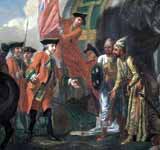
East India Company Nawab of Bengal and French The first battle of Plassey took place on 23 June 1757 in a place called 'Plassey' on the banks of the Ganges River in Nadia district, 22 miles south of Murshidabad. In this war, on one side was the army of British East India Company and on the other side was the army of the Nawab of Bengal. The Nawab Siraj-ud-daulah was defeated by the Company's army under the leadership of Robert Clive. But this war cannot be considered as a victory of the company because before the war, Clive had conspired with three generals of the Nawab, his courtier, and Amir Seth Jagat Seth, etc. of the state. The Nawab's entire army had not even participated in the war, immediately after the war, Nawab was killed by Mir Jaffer's son Meeran. The war is considered very unfortunate for India.
7. Battle of Wandiwash
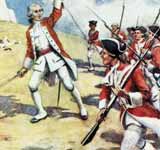
French East India Company British East India Company The Battle of Wandiwash was a decisive battle in India during the Seven Years' War. The French army, led by the Earl of Lally, weakened by a lack of naval and financial support, tried to recover the fort of Vandavasi near Pondicherry. He was attacked by British forces led by Sir Eyre Coote and suffered a decisive defeat. The French contingent of General Bussy-Castelnau was forced to take refuge in Pondicherry, to finally surrender on January 16, 1761.
8. Kargil War
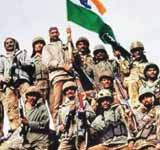
India Pakistan Kargil War, also known as Operation Vijay, is the name of the armed conflict between India and Pakistan between May and July 1999 in Kargil district of Kashmir. Pakistan's army and Kashmiri militants tried to seize India's land by crossing the Line of Control between India and Pakistan. Pakistan claimed that all the fighters were Kashmiri militants, but documents recovered in the war and statements from Pakistani leaders proved that Pakistan's military was directly involved in the war. About 30,000 Indian soldiers and about 5000 intruders were involved in this war. The Indian Army and Air Force attacked the occupied areas of Pakistan and gradually forced Pakistan to return across the border with international cooperation. This war took place on high altitude and the armies of both the countries had to face a lot of difficulty in fighting. This was the first armed conflict between India and Pakistan after the atomic bomb was built.
9. Sino-Indian War
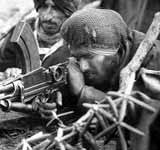
India China The India-China war, also known as the India-China border dispute, was a war between China and India in 1962. The disputed Himalayan border was a main excuse for the war, but other issues also played a role. After the 1959 Tibetan uprising in China, when India gave shelter to the Dalai Lama, a series of violent incidents started on the Indo-China border. The Indo-China war is notable for the fighting in harsh conditions. The Navy or the Air Force were not used by both the Chinese and Indian side in this war. In 1965, at the request of Prime Minister of India Lal Bahadur Shastri, Nizam Mir Osman Ali Khan of Hyderabad donated 5,000 kg of gold to the National Defense Fund to deal with such war situation in future.
10. Battle of Saragarhi
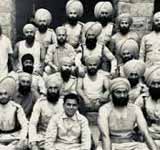
British Raj Afghan Tribesmen The Saragarhi war was fought on 12 September 1897, before the Tirah campaign between the British Indian Army and the Afghan Orakz castes. This battle took place in the North-West Frontier Province (in present-day Khyber-Pakhtunkhwa, Pakistan). There were 21 Sikhs of the 4th battalion of the Sikh Regiment in the British corps, which were attacked by 12,000 Afghans. Havildar Ishar Singh, who was heading the British army, decided to fight till death. It is considered one of the biggest end wars in military history. The description of the battle of Saragarhi is considered to be quite accurate, as British soldier Gurmukh Singh had indicated the events in the fort during the war to Fort Lockhart as heliograph signs.
11. Kalinga War

Mauryan Empire Kalinga The Kalinga war was a conflict fought between 265-264 BCE between the Maurya Empire and the state of Kalinga, a republic of located in the current territory of Orissa. This was the only Great War waged during the reign of Asóka the Great. Kalinga offered strong resistance, but it was insufficient to contain the superior strength of the Maurya army. Excessive bloodshed was the reason Asoka gave for adopting Buddhism. After the conquest, the region was incorporated into the Empire. The Kalinga war led to the decline of the Mauryan Empire. Due to the policy of non-violence, his soldiers fell behind in the art of war. As a result his gradual decline began. The Maurya dynasty fell within 50 years of Ashoka's death. In this war, about 100,000 people were killed and people were taken captive to Magadha and the entire Kalinga region was set on fire.
12. Battle of Buxar
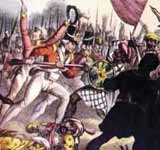
East India Company Mughal Empire The battle of Buxar was fought on 22 October 1764 between Hector Munro of the East India Company and the armies of the Mughal and Nawabs around Buxar Nagar. The joint forces of Nawab Mir Qasim of Bengal, Nabab Shuja-ud-Daula of Awadh, and Mughal Emperor Shah Alam II were fighting the British Company. The British won the battle and consequently the civil and revenue rights of West Bengal, Bihar, Jharkhand, Odisha and Bangladesh went to the British Company. After the defeat of Buxar in the war, the Mughal Emperor Shah Alam, who had already joined the British, entered into a treaty with the British. At the same time there were a few days of fighting between the Nawab Shuja-ud-Daula of Awadh and the British, but due to continuous defeats, Shuja-daula was also forced to surrender to the British and had to make a treaty with the British.
13. First Battle of Panipat
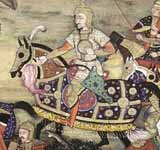
Babur Lodi dynasty The first battle of Panipat was fought in northern India and it laid the foundation of the Mughal Empire in this region. It was one of the first battles that included gunpowder, firearms, and field artillery. In 1526, the army of Zaheer Uddin Mohammad Babur, the Timur ruler of Kabul, defeated a much larger army of Ibrahim Lodi, the Sultan of Delhi, in the battle. The war was fought on 21 April near a small village called Panipat which is located in the present Indian state of Haryana. According to an estimate, Babur's army had around 12,000-25,000 soldiers and 20 field guns. The army strength of Lodi was around 130,000 although this number includes the number of camp followers, while the total number of combat troops was around 100000 to 110,000 with at least 300 war elephants also participating in the war. The Hindu Raja-Rajputs of the region remained neutral in this war, but some Tomar Rajputs of Gwalior fought on behalf of Ibrahim Lodi.
